| Article ID | Journal | Published Year | Pages | File Type |
|---|---|---|---|---|
| 9786246 | Optics Communications | 2005 | 8 Pages |
Abstract
Maximizing the molecular response to coherent anti-Stokes Raman spectroscopy (CARS) requires optimizing the preparation of a vibrational quantum coherence. We simulate the amount of laser-induced coherence prepared in a three-level system modeled after dipicolinic acid (DPA), a marker molecule for bacterial spores. The level spacings and decoherence times were chosen to agree with experimental data observed from DPA. Nearly-maximal vibrational coherences can be induced for 150 fs optical pulses, despite the very fast dephasing rates of the electronic transitions. It is also shown that pulse propagation effects play an important role in the development of coherence throughout an extended sample, due to nonlinear index effects of the molecule at the laser frequencies.
Related Topics
Physical Sciences and Engineering
Materials Science
Electronic, Optical and Magnetic Materials
Authors
G. Beadie, Z.E. Sariyanni, Y.V. Rostovtsev, T. Opatrny, J. Reintjes, M.O. Scully,
